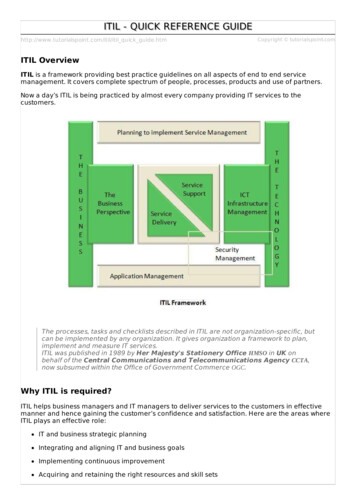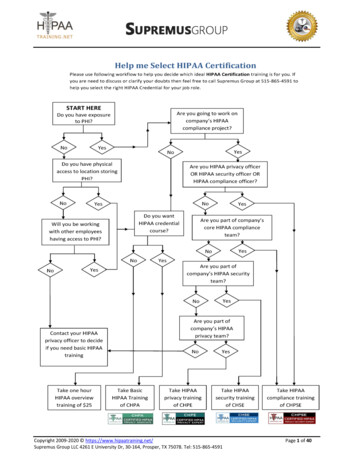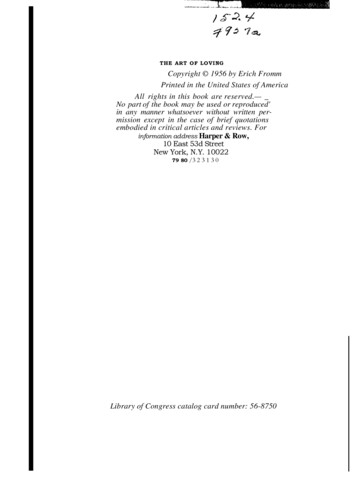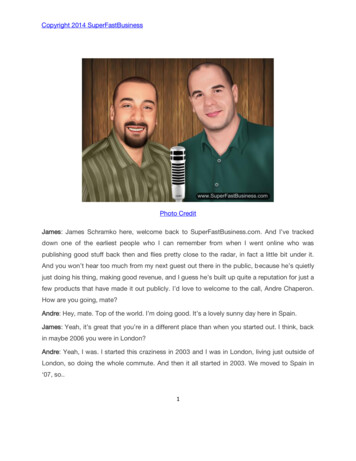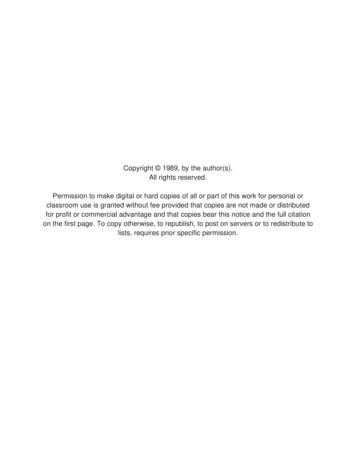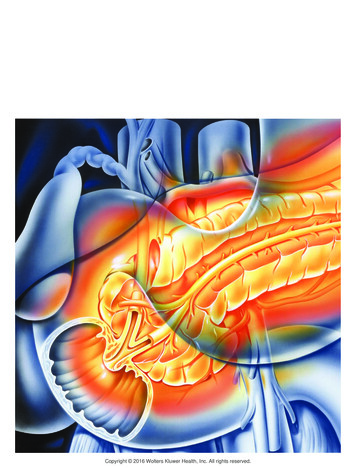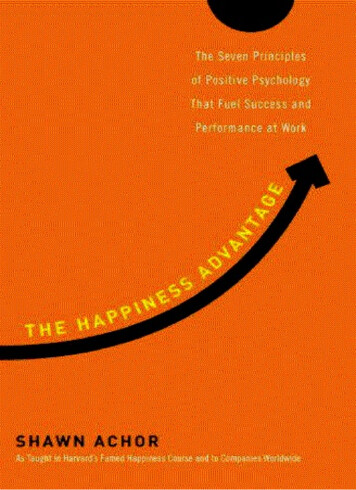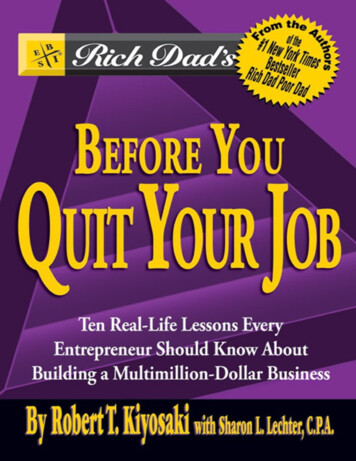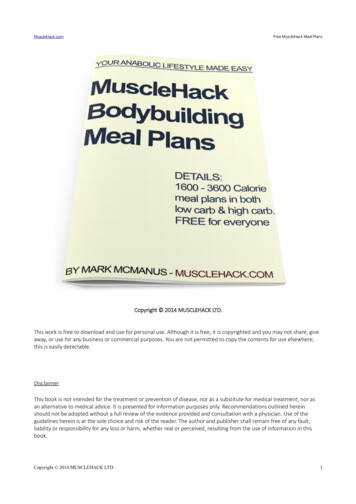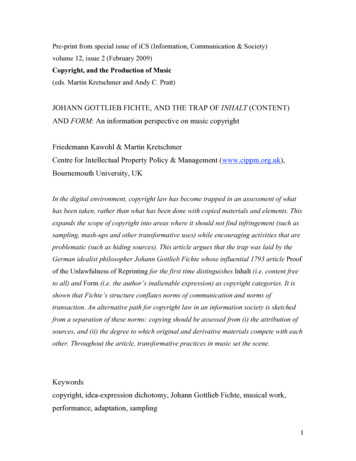
Transcription
Pre-print from special issue of iCS (Information, Communication & Society)volume 12, issue 2 (February 2009)Copyright, and the Production of Music(eds. Martin Kretschmer and Andy C. Pratt)JOHANN GOTTLIEB FICHTE, AND THE TRAP OF INHALT (CONTENT)AND FORM: An information perspective on music copyrightFriedemann Kawohl & Martin KretschmerCentre for Intellectual Property Policy & Management (www.cippm.org.uk),Bournemouth University, UKIn the digital environment, copyright law has become trapped in an assessment of whathas been taken, rather than what has been done with copied materials and elements. Thisexpands the scope of copyright into areas where it should not find infringement (such assampling, mash-ups and other transformative uses) while encouraging activities that areproblematic (such as hiding sources). This article argues that the trap was laid by theGerman idealist philosopher Johann Gottlieb Fichte whose influential 1793 article Proofof the Unlawfulness of Reprinting for the first time distinguishes Inhalt (i.e. content freeto all) and Form (i.e. the author’s inalienable expression) as copyright categories. It isshown that Fichte’s structure conflates norms of communication and norms oftransaction. An alternative path for copyright law in an information society is sketchedfrom a separation of these norms: copying should be assessed from (i) the attribution ofsources, and (ii) the degree to which original and derivative materials compete with eachother. Throughout the article, transformative practices in music set the scene.Keywordscopyright, idea-expression dichotomy, Johann Gottlieb Fichte, musical work,performance, adaptation, sampling1
IntroductionModern copyright law assesses infringement predominantly from a proprietaryperspective. Has anything been taken that is (within the parameters of a protected work)of value? An extreme instantiation is an aphorism from a classic British case of 1916(University of London Press v University Tutorial Press): There, Peterson J suggestedthat ‘what is worth copying is prima facie worth protecting’ – for some even today theultimate test of copyright infringement.1Aesthetic approaches to copying often ignore what has been taken. Instead, they tend toreflect on what has been done with the copied materials. Johann Mattheson’s prescriptionof 1739 is typical for eighteenth century music theory: ‘Taking is a permitted thing; butone must refund what has been borrowed with interest, i.e. one must furnish andelaborate the imitations so that they gain greater beauty and recognition than the piecesfrom which they had been taken.’2Today, the practices flourishing in the digital environment appear to side with the latterapproach, while copyright law has engaged in a rearguard action against sampling,parody, mash-ups, and countless other transformative practices.1The evolution of copyright case law and statutes in the key jurisdictions is much more complex than ourdistinction between ‘what has been taken’, and ‘what has been done to it’ suggests. Yet, current UK law isa good illustration of a broad trend. To be sure, the University of London case is not uncontroversial. Forexample, Lord Justice Jacob suggests in Nova v Mazooma (2007) that findings of copying ‘are the startingpoint for a finding of infringement, not the end point’ (at 26). ‘Otherwise it would require the copying ofinsubstantial parts to be an infringement – which is so absurd as to be assuredly wrong’ (at 29). Contrastthe misappropriation doctrine in the leading infringement decision from the highest UK court (House ofLords). According to Designer Guild v Russell Williams (2002), the infringement test for ‘altered copying’assesses whether the defendant is using the claimant’s skill and labour. If there are sufficient similaritiesbetween original and alleged copy, a ‘substantial part’ question may not even be asked.2The original German wording from Mattheson’s book Der vollkommene Kapellmeister (literally, TheComplete Chapel-Master) reads (1739, p. 131): ‘Entlehnen ist eine erlaubte Sache; man muss aber dasEntlehnte mit Zinsen erstatten, d.i. man muss die Nachahmungen so einrichten und ausarbeiten, daß sie einschöneres und besseres Ansehen gewinnen, als die Sätze, aus welcher sie entlehnet sind.’ All translationsin this article are the authors’ own.2
This article will take a closer look at the philosophical and aesthetical developments thatcoincided with copyright law’s emerging concept of an abstract, self-contained,permanent work as the locus of protection. In the first section, the pre-copyright practicesof music during the eighteenth century are sketched, and then contrasted with theaesthetic assertions of the musical work as an independent branch of the arts during theearly years of the nineteenth century. The second section argues that the correspondingrestrictive approach to copyright infringement (as applied, for example, to performancesand arrangements) takes its lead from Johann Gottlieb Fichte’s distinction of Inhalt(content) and Form in his 1793 article Proof of the Unlawfulness of Reprinting. The thirdand final section proposes an alternative model that, it is argued, resolves the tensionsbetween digital information pastiche and copyright law in a coherent way.The aesthetic transformation: constructing abstract worksDistinctions between original and copy, between work, adaptation and performance, arealien to musical practices pre-1800. These categories are the result of an aesthetic andlegal turn we locate in the dichotomy of Inhalt (content) and Form that underpins, incontradictory ways, romantic aesthetic theory and legal philosophy.Central to the musical practice of the seventeenth and eighteenth century was not thework of a particular composer but the event, the unique performance in a specific ritualcontext. This applies to religious functions, to dance music at court, and also to earlyopera. Of lasting artistic standing was not the music, but the play. Opera plays wereprinted as ‘little books’ (libretti), sold and distributed even abroad, while the musicalscores remained unpublished. On the poster for the first performance of the Magic Flute(1791), the name of Emanuel Schikaneder (playwright, actor and entrepreneur) is printedmuch larger than Mozart’s.Recognised classical sources were regurgitated again and again, in particular in theversions of Pietro Metastasio whose libretti were set to music by dozens of composers.Each season, a different Kapellmeister may have been responsible for the musical3
direction. He (it was always a he) would write new music, often integrating the mostsuccessful arias of the past seasons. For example, a Florentine production of Metastasio’sDidone abbandonata of 1725, integrated arias by no less than three composers (Vivaldi,Orlandini, and Gasparini). Centre stage was not the composer whose works were to bereproduced according to his intentions but a practical musical mind, the Kapellmeisterwho adjusted the available musical material to the abilities of the singers, and to thedramaturgic constraints of the occasion.In churches and monasteries, older music persisted for longer, and was also copied anddistributed. But here too, the scores were continuously modified and adjusted forchanging tastes and occasions. The contracts of court and church composers typicallyregulated the provision of music, but did not care where the material came from, or whowrote it (Pohlmann 1962).Opera entrepreneurs, court administrators, church officials, even musicians and theiraudience paid little attention to sources or authenticity of music. J. S. Bach, according toan analysis of his manuscripts, never copied a work without making changes (Marshall1972). G. F. Händel frequently used melodies of contemporary composers as themes forhis own works (Buelow 1987). For Mozart’s Magic Flute, 43 borrowed melodies havebeen identified, 33 from his own works, three each from pieces by Haydn and Gluck, andone each from Gassmann, Benda, Wranitzky and Philidor (Hyatt King 1950).During the course of the eighteenth century, these all-pervasive practices of change,customisation and appropriation eventually became problematic, as a new conception ofmusic took hold. Historically aware copyright scholars (Woodmansee & Jaszi 1994;Boyle 1996; Marshall 2005) have recognised a, then new, demand for ‘originalauthorship’ associated with the literary theory of the time. One of the earliest writers toplea for originality, rather than conformity to classical rules was Edward Young in hisConjectures on Original Composition (1759, §80): ‘As far as a regard to Nature, andsound Sense, will permit a Departure from your great Predecessors; so far, ambitiously,depart from them; the farther from them in Similitude, the nearer are you to them in4
Excellence; you rise by it into an Original; become a noble Collateral, not an humbleDescendant from them.’ And indeed, by the end of the century, this was widely accepted.The productions of true artists would need to be characteristic, reflecting a uniquepersona.However, we contend that a genius aesthetics itself is not sufficient to explain thetransformation associated with the turn to the nineteenth century. For music, the aestheticpropertisation of genius relied on an emerging conception of the abstract work that maybe boldly summarised in five propositions:(1) Imitation, emulation and originality are mediated by formWhile according to pre-modern aesthetic standards, artefacts were judged against theirsimilarity (resemblance) either to nature or to earlier artefacts, post-Kantian aestheticsfocusses on the creator’s person and the relation to her predecessors in gauging both – thedegree of emulation and the distinction as a creative personality. Form is the flexibleconcept that allows both attributions: emulation and personal marking. The demand forgenius is mediated by form. In Immanuel Kant’s words (Kritik der Urteilskraft 1790,§49): ‘The product of a genius is not an example of imitation (since the essence of thegenius and of the spirit of work would be lost) but rather an example of emulation[Nachfolge] of another genius. It is through emulation that the consciousness is woken toits own originality.’ [‘Nach diesen Voraussetzungen ist Genie: die musterhafteOriginalität der Naturgabe eines Subjekts im freien Gebrauche seinerErkenntnisvermögen. Auf solche Weise ist das Produkt eines Genies (nach demjenigen,was in demselben dem Genie, nicht der möglichen Erlernung oder der Schule,zuzuschreiben ist) ein Beispiel nicht der Nachahmung (denn da würde das, was daranGenie ist und den Geist des Werks ausmacht, verlorengehen), sondern der Nachfolge fürein anderes Genie, welches dadurch zum Gefühl seiner eigenen Originalität aufgewecktwird.’] A nineteenth-century composer writing a symphony is always both emulatingBeethoven in his ‘form’ (four movements, sonata form, modulations etc) as well as5
marking off his personality from Beethoven’s by using other techniques and varyingformal elements.3(2) Music is an autonomous branch of the artsEighteenth century debates about originality mostly focused on poetry and paintings,rarely on music. Music, in the hierarchy of the arts, was considered not as a work (ergon),but as an activity (energeia) – to use Humboldt’s later analogy to language (1836). ThusMattheson (1739, 82) talks of music as Ton-Sprache or Klang-Rede, literally ‘a speech insound’. The aesthetics of the nineteenth century almost reversed that hierarchy, coiningthe term ‘absolute’ for music that did not depict or speak (Dahlhaus 1978). Now, theabstract harmonic and thematic relations, in particular within non-verbal instrumentalmusic, were seen as a superior art, constructing an autonomous text open to formalanalysis. This avoided the common allegation that music merely played with sentiments,thus not addressing the higher human faculties (Kant 1790, §269), and satisfied thedemand that art be evaluated according to autonomous criteria, not through the similarityto natural phenomena (ibid., §49) .(3) Within abstract works of music there can be a distinction between content and formThe formal relations within a work of music may be decoded to reveal an abstractcontent. As the philosopher Arthur Schopenhauer writes (1988 [1819], p. 345): Musicexpresses the inner substance, ‘the will itself’ – not a particular joy or sadness but ‘thejoy’, or ‘the sadness’ in abstracto. This slightly mysterious thought achievedconsiderable popularity among bourgeois music lovers, culminating in the critic EduardHanslick’s circular dictum of 1854 that ‘moving forms in sound’ (tönend bewegteFormen) constitute the ‘content of music’ (Inhalt der Musik). The central controversy fornineteenth century music becomes the choice between the aesthetics of form3The tension between originality and imitation became a lasting problem of romantic theory: How couldone distinguish originality from contrived folly? As Schlegel (1991 [1797], p. 52) puts it: ‘The greater thealready existing mass of originality, the rarer becomes new true originality.’6
(Formästhetik, exemplified by Brahms) and the aesthetics of content (Inhaltsästhetik,exemplified by Wagner).(4) Performers separate from composers into interpreters of formComposing as a profession did not exist prior to the concept of the musical work. Earliermusicians were employed as Kapellmeister or instrumentalist. A few becameentrepreneurs in organising operas or concerts (Händel and Bach/Abel in London). Manyfree-lance composers of the early nineteenth century earned their living as pianists, oftenplaying their own works (Beethoven, Liszt, Chopin). During the nineteenth century, anew form of concert programming appears, presenting works by past composers. Thiscan be traced in the performing life of Clara Schumann (1819-1896). During the 1840s,her programmes still include improvisations (Fantasie) and virtuosic arrangements ofpopular melodies; after about 1850,
For example, a Florentine production of Metastasio’s Didone abbandonata of 1725, integrated arias by no less than three composers (Vivaldi, Orlandini, and Gasparini). Centre stage was not the composer whose works were to be reproduced according to his intentions but a practical musical mind, the Kapellmeister who adjusted the available musical material to the abilities of the singers, and to .



